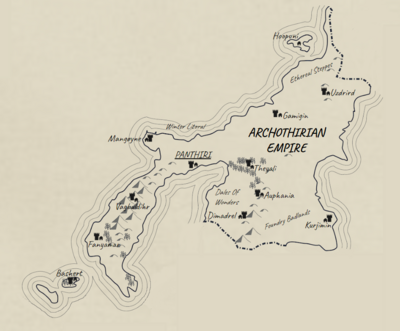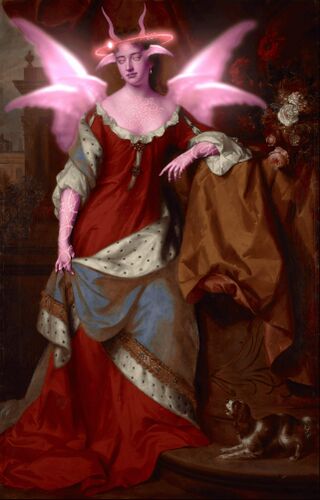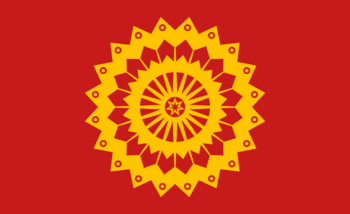Archothirian Empire (Aurora)
Archothirian Empire "Impero Arcotiriano" "Imperium Archothirium" "Aftorekras Arkhothirio" "𐎠𐎳𐎠𐎽𐎭 𐎧𐏁𐏂" | |
|---|---|
|
Flag of the Archothirian Empire. | |
 Map of Archothirian Dominions. | |
| History | |
| Location | Northern Zalora |
| Allies |
|
| Government | |
| Type | Constitutional monarchy |
| Ruling House | Malphasamael Dynasty |
| Head of State | Jophiel, Charun and Eisheth Malphasamael |
| Legislature | Council Of Royals |
| Military | Archothirian Imperial Forces |
| Socio-cultural characteristics | |
| Motto | A.E.I.O.U. ”Achothiria Est Imperare Orbi Universo.“ ”It is Archothiria’s destiny to rule the whole world.” |
| Capital | Panthiri |
| Official languages | Archorian |
| National languages | Archorian Rolamtinu Elladan Aecyrinid |
| Races | Beastfolk Clockworks Cloud Fae Dwarves Elementals Elohim Elves Gnomes Hybrids Humans Illusionals Merfolk Orcs Shadowlings Sheseirim Triclops |
| Religion(s) | Fracturalism (Imperial Religion) Kpherism Siddarthism Shamanism Pattermajism Bashonastrism |
| Demonym(s) | Archothirian; Archian (more archaic and less used) |
| Population estimate | 37.7 million |
| Currency | Erpyon |
- Go back to Aurora - Go back to the List of nations.
The Archothirian Empire, also simply known as Archothiria (ɑɹkoʊθɪɹɪən; Archorian: Impero Arcotiriano) is a thaumaturgical empire based in northern Dracoris. Archothiria borders with the Novus Daemonica Empire on it’s north, and the Oskbaric Ocean on both it's east and west. The Empire's territories are highly diverse in both terrain and biome, and almost all of them are characterized by a varying degree of highly anomalous and magical characteristics, such as the extreme tundral-tropical temperature variations of the Winter Litoral, the floating islands of the Emunian Plains, and the paradoxically warped landscapes of Hoopuni. As such, a very large percentage of Archothirian fauna and flora are infused with and make use of magic. As of the current age, the Archothirian Empire spans a total of approximately 560.000 square toors, and has a total population of 37.7 million, currently making it the most populous empire in Aurora, as well as one of the most territorially expanded.
The Empire traces its origins back to the AngeloDemonic Wars of Unification of the first century, when the Elohimian Order and the Sheseirim Domain, now united under the single ruling dynasty of the Malphasamaels in the AngeloDemonic Unity, conquered the other nations that had emerged in the area after the Fracture, bringing them all under a single banner. The Archothirian Empire was then officially founded in Anno 106 with the New Archian Imperial Constitution (Archorian: Nuova Costituzione Imperiale Archiana), that created the first institutions, laid the inner workings of the newborn Empire's government and administration, and established its first laws. The document, known as the Archothirian Constitution in the current age, is still in use almost a full millennium later, although it has gone through significant additions and changes since it's first ever draft.
The Archothirian Empire is inhabited by a wide variety of races, most of which originated from their ancestors who "fell" in Aurora's plane of reality following the Fracture. The only exceptions are Humans, who were already living in the area before the Fracture, and the Cloud Fae, whose mobile cloud hives first reached the Empire's territories in the second century. All races within the Empire share equal status with one another, and over the centuries have thoroughly mixed with: most communities and settlements within Archothiria are highly cosmopolitan and diverse, although certain races tend to be more prevalent in different Monarchates. In recent months, as the Archothirian Empire put an end to it's nearly millenary period of isolation, new races like the Lightfolk and Belsedori have started to possess a token presence in the form of merchants and other travellers, mostly not on a permanent basis yet.
Etymology
The etymology of the name "Archothira" derives from the fusion of two ancient Elladan words: "arkho", an ancient term that had a double meaning of superiority and universality, and "thirio", meaning "beast " or more generally "creature". Thus, the literal translation of the composite word "Arkhothirio" would be "of all creatures", and pairing it with the Elladan term "Aftorekras", currently translated as "Empire" or "Dominion", would make Archothiria the "Empire Of All Creatures".
However, it should be noted that all three Elladan terms derived from even older terms, whose etymology is still highly uncertain and disputed between scholars, due to their pre-Fracture origins.
History
Geography
Climate
Ecology
Magically Anomalous Territories
Government and Politics
The Archothirian Empire is a highly structured Constitutional Monarchy in which power, limited and regulated by the Archothirian Constitution, is shared between the Archothirian Emperors and the Council of Royals. Executive power is held by the Emperors and Judiciary power is held by the Council of Royals, while Legislative power is shared between the two. Both bodies were officially instituted and formed with the New Archian Imperial Constitution in 106, although the Emperors already partially existed with the Malphasamael monarchs of the AngeloDemonic Unity.

Archothirian Emperors
The Emperors (Archorian: Imperatori) are the Heads of State of the Archothirian Empire, holding both executive and legislative power, although the latter is fully shared with the Council of Royals.
As heads of the Executive Branch, the Archothirian Emperors:
- Act as the commanders-in-chief of the Archothirian Imperial Forces.
- Declare states of emergency and publish regulations and executive orders.
- Veto bills passed by the Council of Royals.
- Make executive agreements and sign treaties ratified by a majority approval of the Council of Royals.
- Grant pardons for offenses against the Archothirian Empire, except in cases of Impeachment.
As part of the Legislative Branch the Archothirian Emperors, together with the Council of Royals:
- Pass bills, together with the Council of Royals.
- Regulate inter-state commerce.
- Control the national budget.
- Declare war.
- Oversee and make the rules for the Imperial government and its officers.
The position of Archothirian Emperor or Empress is partially hereditary: the title is passed from the reigning monarch, known as the High Emperor or Empress, to the child or closest relative that they consider most fit for the position, often with the advice of the Council of Royals. Through marriage, the title is partially extended to all partners of the monarch that inherited the Imperial Crown: these figures, called Secondary Emperors, have less power than their primary partner, and act more as their Royal Advisors or Privy Council. However, Secondary Emperors can also act as temporary regents if the inheritor of the crown is too young to properly rule.
The current High Empress of the Archothirian Empire is the Elohim-Sheseirim hybrid Eishet Baraqiel Malphasamael, who inherited the throne in 1087 after the death of her mother and predecessor Gadreel Penemue Malphasamael. In 1093 she married with her two partners Jophiel Mahishasur and Charun Naberus, that were subsequently crowned and became the empire's current Secondary Emperors.
